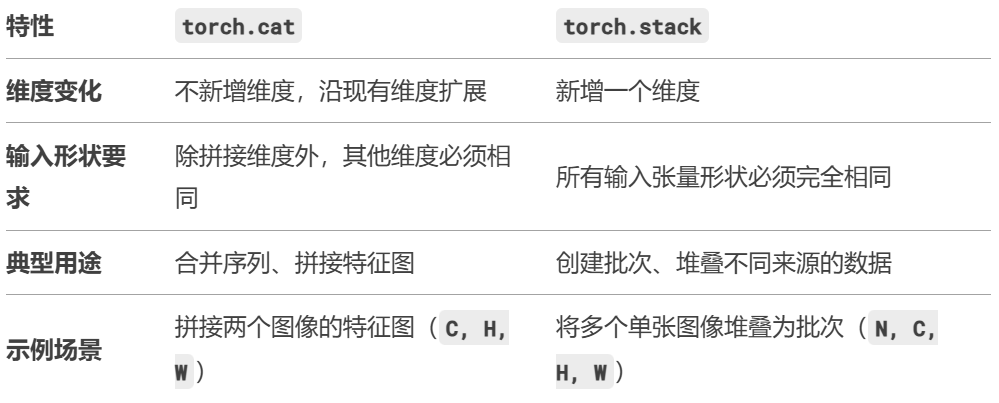torch.cat和torch.stack的区别
torch.cat 和 torch.stack 是 PyTorch 中用于组合张量的两个常用函数,它们的核心区别在于输入张量的维度和输出张量的维度变化。以下是详细对比:
1. torch.cat (Concatenate)
- 作用:沿现有维度拼接多个张量,不创建新维度
-
输入要求:所有张量的形状必须除拼接维度外完全相同。
-
语法:
torch.cat(tensors, dim=0) # dim 指定拼接的维度 -
示例:
a = torch.tensor([[1, 2], [3, 4]]) # shape (2, 2) b = torch.tensor([[5, 6]]) # shape (1, 2) # 沿 dim=0 拼接(行方向) c = torch.cat([a, b], dim=0) print(c) # tensor([[1, 2], # [3, 4], # [5, 6]]) # shape (3, 2) - 特点:
-
拼接后的张量在指定维度上的大小是输入张量该维度大小的总和。
-
其他维度必须完全一致。
-
2. torch.stack
-
作用:沿新维度堆叠多个张量,创建新维度。
-
输入要求:所有张量的形状必须完全相同。
-
语法:
torch.stack(tensors, dim=0) # dim 指定新维度的位置 -
示例:
a = torch.tensor([1, 2]) # shape (2,) b = torch.tensor([3, 4]) # shape (2,) # 沿新维度 dim=0 堆叠 c = torch.stack([a, b], dim=0) print(c) # tensor([[1, 2], # [3, 4]]) # shape (2, 2) # 沿新维度 dim=1 堆叠 d = torch.stack([a, b], dim=1) print(d) # tensor([[1, 3], # [2, 4]]) # shape (2, 2) -
特点:
-
输出张量比输入张量多一个维度。
-
适用于将多个相同形状的张量合并为批次(如
batch_size维度)。
-
3. 关键区别总结

4. 直观对比示例
假设有两个张量:
x = torch.tensor([1, 2]) # shape (2,)
y = torch.tensor([3, 4]) # shape (2,)torch.cat 结果:
torch.cat([x, y], dim=0) # tensor([1, 2, 3, 4]), shape (4,)torch.stack 结果:
torch.stack([x, y], dim=0) # tensor([[1, 2], [3, 4]]), shape (2, 2)
5. 如何选择?
-
用
torch.cat当需要扩展现有维度(如拼接多个特征图)。 -
用
torch.stack当需要创建新维度(如构建批次数据或堆叠不同模型的输出)
通过理解两者的维度变化逻辑,可以避免常见的形状错误(如 size mismatch)。
